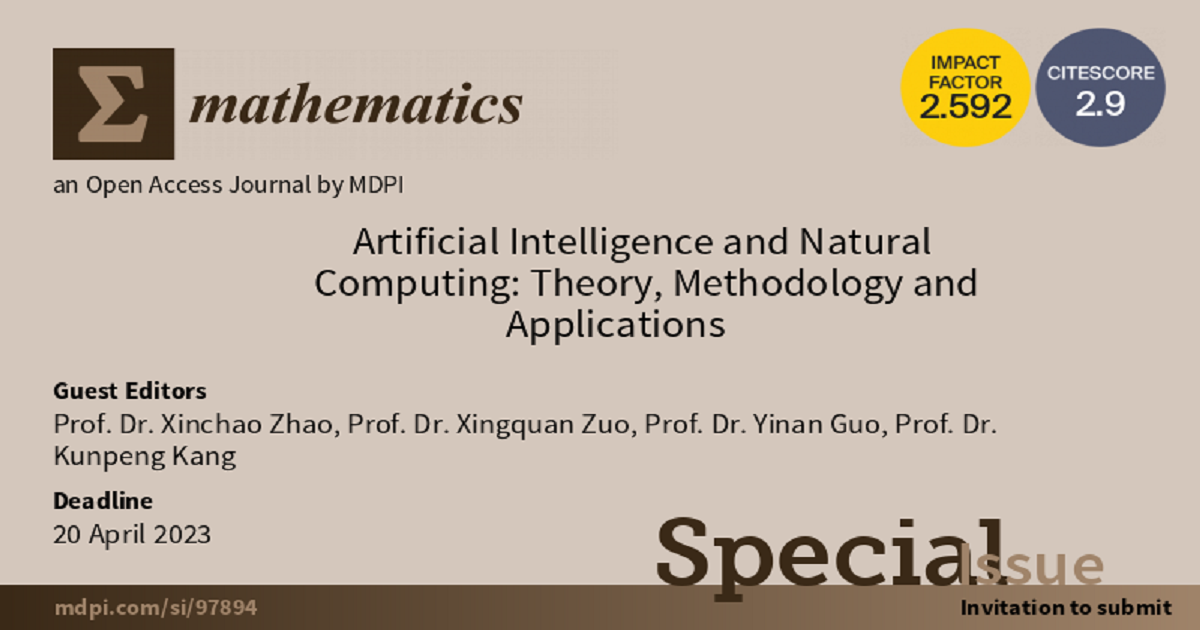Artificial Intelligence and Natural Computing: Theory, Methodology and Applications
A special issue of Mathematics (ISSN 2227-7390). This special issue belongs to the section "Computational and Applied Mathematics".
Deadline for manuscript submissions: closed (20 April 2023) | Viewed by 33415

Special Issue Editors
Interests: swarm intelligence; operations research
Special Issues, Collections and Topics in MDPI journals
Interests: intelligent optimization; data mining; artificial intelligence; intelligent transportation systems
Special Issues, Collections and Topics in MDPI journals
Interests: wireless sensor network; dynamic optimization; evolutionary optimization
Special Issues, Collections and Topics in MDPI journals
Special Issue Information
Dear Colleagues,
In the last few decades, the role of artificial intelligence and natural computing has aroused more and more attentations, and also been successfully applied to engineering, economics, scheduling and so on.
This Special Issue will present recent research results in Artificial Intelligence and Natural Computing: Theory, Methodology and Applications. Natural Computing is a family of biologically inspired population-based algorithms for global and combinatorial optimization. It is also one of the most important tools for providing an effective and efficient solution to many real-word engineering problems due to their flexibility and capability to solve multimodal problems.
This Special Issue is focused on the artificial intelligence and natural computing: theory, methodology and applications. Potential intelligence, optimization and application topics include but are not limited to the following:
Foundation of artificial intelligence;
Natural computing;
Evolutionary computation and neural network;
Evolutionary combinatorial optimization and metaheuristics;
Evolving hardware and developmental systems;
Evolutionary learning and deep learning;
Surrogate model for optimization;
and applications on:
Multimodal optimization;
Constrained optimization;
Multiple objective optimization;
Industrial engineering;
Portfolio optimization;
Engineering optimization;
Information and cyberspace security;
Cloud computing;
Layout and route optimization;
Complex network;
Communication network;
Search-based software engineering.
Prof. Dr. Xinchao Zhao
Prof. Dr. Xingquan Zuo
Prof. Dr. Yinan Guo
Prof. Dr. Kunpeng Kang
Guest Editors
Manuscript Submission Information
Manuscripts should be submitted online at www.mdpi.com by registering and logging in to this website. Once you are registered, click here to go to the submission form. Manuscripts can be submitted until the deadline. All submissions that pass pre-check are peer-reviewed. Accepted papers will be published continuously in the journal (as soon as accepted) and will be listed together on the special issue website. Research articles, review articles as well as short communications are invited. For planned papers, a title and short abstract (about 100 words) can be sent to the Editorial Office for announcement on this website.
Submitted manuscripts should not have been published previously, nor be under consideration for publication elsewhere (except conference proceedings papers). All manuscripts are thoroughly refereed through a single-blind peer-review process. A guide for authors and other relevant information for submission of manuscripts is available on the Instructions for Authors page. Mathematics is an international peer-reviewed open access semimonthly journal published by MDPI.
Please visit the Instructions for Authors page before submitting a manuscript. The Article Processing Charge (APC) for publication in this open access journal is 2600 CHF (Swiss Francs). Submitted papers should be well formatted and use good English. Authors may use MDPI's English editing service prior to publication or during author revisions.
Keywords
-
foundation of artificial intelligence
- natural computing
- evolutionary computation and neural network
- evolutionary combinatorial optimization and metaheuristics
- evolving hardware and developmental systems
- evolutionary learning and deep learning
- surrogate model for optimization
- multimodal optimization
- constrained optimization
- multiple objective optimization
- industrial engineering
- portfolio optimization
- engineering optimization
- information and cyberspace security
- cloud computing
- layout and route optimization
- complex network
- communication network
- search-based software engineering
Benefits of Publishing in a Special Issue
- Ease of navigation: Grouping papers by topic helps scholars navigate broad scope journals more efficiently.
- Greater discoverability: Special Issues support the reach and impact of scientific research. Articles in Special Issues are more discoverable and cited more frequently.
- Expansion of research network: Special Issues facilitate connections among authors, fostering scientific collaborations.
- External promotion: Articles in Special Issues are often promoted through the journal's social media, increasing their visibility.
- e-Book format: Special Issues with more than 10 articles can be published as dedicated e-books, ensuring wide and rapid dissemination.
Further information on MDPI's Special Issue polices can be found here.






